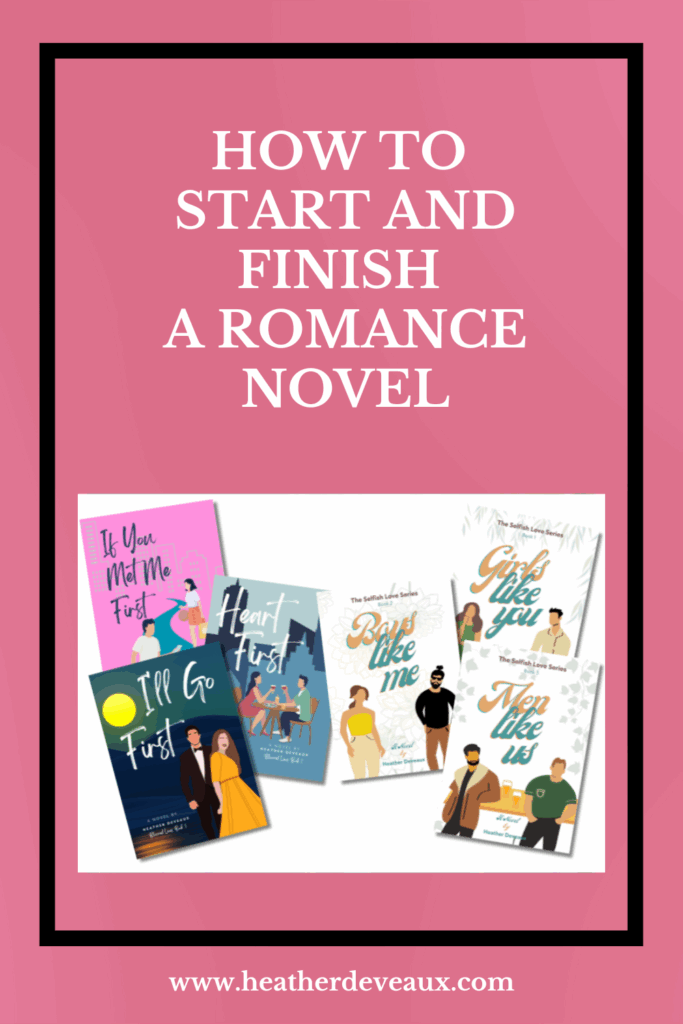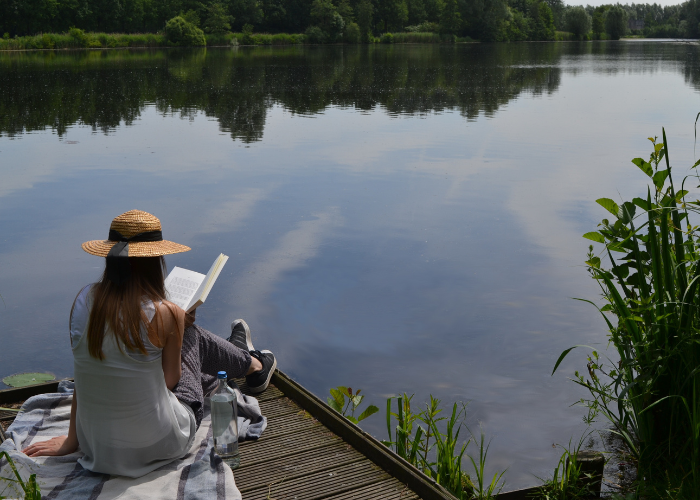How to Start and Finish a Romance Novel Step-by-Step
I’m not going to lie: I love it when people ask me about my writing process. It’s not because I have a super secret way of writing romance novels, but because I actually love talking about the process. I’ll tell anyone who will listen. So you can imagine my delight when someone reached out to me on Instagram this week to ask about my writing process. They were looking for advice to work toward the final product and I responded with so much information I realized it needed to be a blog.
I’ve also created a step-by-step resource for you if you want a quick reference for the process that’s available at the end of this post. But if you want the meat and potatoes of how to start and finish a romance novel, here’s what I do. Feel free to take the process and make it your own.

My Writing Experience: Start and Finish a Romance Novel
Before we dive into my step-by-step process on how to start and finish a romance novel, I want to tell you about some of my writing experience. Some people write one book and then turn around and try to teach other people how to do the same thing. That’s not what this is. I’ve actually written over a dozen different books over the last ten years including both romance novels and non-fiction, business books.
What’s funny about writing romance novels is that the physical process of writing isn’t any different from writing a non-fiction book. The content is…well, er..spicier. But the spice factor doesn’t take away from how much work goes into writing a romance novel, the same way the lack of spice in a non-fiction book makes it boring.
More than writing books though, I’ve been writing making my living as a writer of some sort for the last decade. I started my full-time entrepreneurial journey as a freelance writer, creating content for other businesses. Before that, I was writing educational content for universities, colleges, businesses, and non-profit organizations. I had a side hustle once where I wrote a career newsletter and sold ads within the newsletter to fund it. That was before job boards on the internet took off, but the point is, I’ve been writing in some form or another my entire life.
Writers Gonna Write. Or Not.
I don’t tell you about my writing experience to scare you off. You might be sitting there chewing on your nails because you’re thinking, “I’ve got no writing experience.” What I want you to know about writing experience is that you’re not born with it. Sure, some people have a natural interest in writing, but that interest alone doesn’t make them good writers.
All the interest in writing does is make it easier for them to sit down and write something. For people who have a tentative interest, the good news is that you can still write and your not-always-keen-interest doesn’t mean that you can’t ever write something. What I’ve learned about being a writer is that it’s the consistency that wins out in the end to actually get words on the page. But it’s the willingness to learn HOW to put those words on the page that really moves the needle.
Despite having written several business books before attempting to write a romance novel, I knew instinctively they were different animals. I knew how to string some sentences together to make a point or share a perspective in a non-fiction book. I knew how to conduct research to promote my ideas and build foundation under my arguments. But when it came to getting a character that I had to invent out of thin air from the start to the finish of an entire story without holes in it, I knew I had a few things to learn.
You Can Learn to Write
So I want you to find comfort in the fact that even someone with a lifetime of writing experience still had to learn how to write a romance novel. There is no secret sauce to being a writer. Anyone who tells you that it’s a God-given talent is a liar and probably lacking real self-awareness. Writing is a skill that can be learned and developed like any other skill humans are capable of having. And I want to show you how you can start and finish a romance novel in case you have questions about it and want to learn how to do it for yourself.
Where to Find Ideas for to Start and Finish a Romance Novel
One of my favourite questions about writing romance novels is where I get my ideas. Life. My ideas come from life. I write contemporary romance novels which means my stories are happening in the here and now. I love a good dragon romance as much as the next person, but that’s not the kind of writing I’m into. I’m into men with money, women who don’t settle, and navigating the realities of dating in the real-fake world.
I’m also super obsessed with happy endings and even though I don’t plan to get married again in my lifetime, my characters always get their beautiful weddings. Did I know that this was going to be a framework for my romance novels when I started writing one? No. And the first ugly draft of my first romance novel was wildly terrible. But once I got that wildly terrible version on the page, I learned how to make it better.
Reading to Write
I read a lot of romance novels. Like, a lot. I probably spend more buying books than some people pay for their car every month. No shame here. I read so many romance novels because before I started writing, I studied what made a good romance novel good. Reading about what the characters could be and what the world could look like and what problems they encountered helped me figure out story lines.
I studied the covers and the designs and the titles. I noticed a lot of trends and then I threw all of that out like last week’s dinner rotting in the fridge and started with a blank piece of paper. You can get your ideas form anywhere, but I’m willing to bet you’ve already got some. I have based every novel I’ve written (and I’ve written seven now) on a single idea or thought. Here’s the main idea I had for each novel.
Ideas That Sparked My Romance Novels
If You Met Me First: I wanted to write an office romance. So when I sat down to pick apart my first shitty draft, I decided this book was going to be the office romance book. It was that simple.
Heart First: I wanted this book to about about finding yourself on a road trip. I made the main male character the brother of the woman in If You Met Me First to keep the story going.
I’ll Go First: I wanted this book to be about a middle-aged man who had never married but had been building a life for a woman he trusted he’d meet. He just didn’t know she was going to be wild fire. I made the characters in this book related to the characters in Heart First and friends with the characters in If You Met Me First. Ta-da! A whole world of people just trying to find love. This was my friends-to-lovers trope book and it was so fun to write conflict that was heated with something other than anger.
Other Ideas for Romance Novels
In my second trilogy, The Selfish Love Series, I was obsessed with the idea of second chances.
Girls Like You: I wanted to write a book about a man who was still in love with his high-school sweetheart twenty years later. They’re 40ish now and haven’t come close to finding someone else to love. And then they find each other again.
Boys Like Me: Friends of the duo in Girls Like You, I wanted to explore the idea of a one night stand turned long-term relationship.
Men Like Us: I had just read Red, White and Royal Blue and had been thinking about how to work in the brother character from Boys Like Me when I decided to write a gay romance. It meant going back and rewriting several aspects of the first two books in the trilogy, but because I purposefully publish my trilogies together for this exact reason (who know where the stories will go by the time they are done!) it was easier to make the changes.
My Current Idea for a Romance Novel
My current novel, which remains untitled, came about when the line, “There’s nothing on that wine list written as well as your book,” came to my mind, imagining a man approaching a woman in a restaurant who was a fan of her writing.
You can find ideas from your own life, from people watching or from stories you see on the internet. You can also start with a single idea, thought or line and go from there. There are no rules. Don’t let anyone tell you there are. It’s your project. You get to decide what constitutes a good idea.
What Tools Do You Need to Write a Romance Novel?
Funny question. Even funnier answer: I use Google Docs. I know there are plenty of writing tools and software programs on the market that make writing easier. But the way I’m going to teach you to write means you don’t need those things. I use Google Docs. When I write, I write each chapter in its own document. I organize my chapters in a folder. Bob’s your uncle. Robert is also my father’s brother, but I digress. Let’s talk about writing. Keep it simple. Always.
Start at the Beginning
I’m going to give you some unconventional advice here because it’s been working for me my entire life. Whether I’m writing a blog post like this one or I’m writing a romance novel, I always, without fail, start writing at the very beginning. The reason I do this is two fold: first, my brain just works in a linear fashion. I can see the end result long before I get there and that means I just have to keep writing to get there.
Second, I find it helpful to know the main story line so that, in the case of my trilogies, I can track events or issues back easily for future reference or in the case of my stand-alone novel that I’m working on now, I can check for major plot holes. So many plot holes.
The Learning Doesn’t Stop
I have to be honest about the difficulty level of writing a stand-lone novel instead of writing an series of intertwined, related stories in my trilogies. I found it much easier to let a story unfold over several books than to try to keep it contained in one book like I am right now. But that’s also part of the learning process. I wanted to learn how to write a stand-alone novel. Regardless of the struggle I have experienced to keep the story flowing, I started in the same place I always start: at the beginning.
Here’s a tip I picked up from doing research about writing novels that I loved and implemented: start your story at the last possible moment before the first major conflict happens. Open the book with something important. That grabs the attention of the reader, apparently, but also, I really liked how it felt to write and how it landed with the rest of the stories. Give it a try.
One the reasons I’ve been able to write so many books in such a short period of time is because I wasn’t afraid of doing it wrong. I think a lot of would-be-writers want to know the exact steps to take before they ever write a word on the page, but I knew that in order to be better at something, I had to be bad at it first. This gave me the permission I needed to just see what would happen if I tried to write a romance novel.
If you need permission to be bad at this, consider it given. There’s no prize for writing a good novel on the first go around. It will take longer than you think and be more work than you think, so just settle into the process.
Write in Sequential Order
Again, I’m going to give you some unconventional advice when it comes to learning how to start and finish a romance novel: write the events in the order they happen. Why? Because that’s how life works. One conversation leads to a meeting leads to a fall out leads to a reconciliation. It never even occurred to me to write the conflict pieces first. I want to know how my characters got to the conflict. I want to know their backstory. So I write my books in order.
This sequential approach to writing romance novels means, as I mentioned earlier, that I can go back and fact-check my own writing easily enough. When I was deep into writing The Blurred Lines Series and was struggling to tie story lines together over three books, it was easy for me to go back, document major milestones in the books on sticky notes, and then move them around after the fact to rewrite the parts that needed to be rewritten. But we’re not talking about editing yet. That’s another step for later. The point is, though, that when you’re writing from start to finish, you can follow the plot line easier and faster.
What About the Outline?
I’m going to let you in on my big writing secret: I don’t write an outline. I don’t follow an outline. Hell, I don’t even create an outline. I write. Sure, you can create an outline if you like, but then you end up spending more time trying to get the outline right instead of actually writing. And when it comes to learning how to start and finish a romance novel, there’s only one thing that is going to get you across that finish line: actually writing.
I don’t use an outline because I don’t want to make any assumptions about HOW my story is going to unfold. I know WHERE it’s headed because I’ve got my happily-ever-after framework, but HOW my characters get there is totally dependant on my mood and what I want to write. And I spend a lot of time tapping into my feelings as I write to guide the writing.
I think about how someone would really react in a situation and then I write how I wish they’d react. It’s a funny little trick I use that makes my male characters swoon-worthy. Men written by women are the best. So I usually just write the opposite of what I’ve seen or heard in real life and that makes the characters pop. But as far as outline goes, I skip it.
I also don’t write backstories for my characters. Because I write in sequential order, I am able to reveal and unravel complicated character traits as I write. In this way, writing has become even more enjoyable for me because I’m discovering my characters as the story unfolds. This makes me more invested in their happy endings and it allows me to find the places where the characters fit together throughout the story.
Getting to the End of the First Draft
I’ve actually spent a lot of time on the getting started phase because that’s what I hear from people the most: “I don’t know where to start.” If you start in the middle of the story, you’ll complain that you don’t know how to go back and fill in the blanks. If you start at the beginning, you’ll be better equipped to just keep telling a story. Nobody said it had to be a good story, by the way, and for the love of God, don’t write it like anyone is going to read it just yet. This is for your eyes only. You’re creating something that won’t make sense to other people just yet. So stick with it.
When it comes to finishing the first draft of your romance novel, my advice is this: write a chapter every time you sit down. Keep chapters focused on one idea or event. See it through to the end of the idea or event and then start a new chapter. Even if you have to write nonsense on an entire page just to get through the chapter, do it. You can clean it up in the editing phases. What matters is you keep the story going. If you’re stuck on what to write, use placeholder names, events, whatever. Don’t leave the page blank.
No Edits. Not Yet.
When I’m writing my first draft of a romance novel, I don’t stop to edit as I go. I never do this. I never do this because I’ll lose my writing time trying to make the story better and it just wastes my time. My only goal when I’m writing a shitty first draft is to finish it. I also don’t worry about formatting, story line, flow, character traits, place names, timelines or events. I just write them as I think they’re happening.
What I do spend a lot of time doing while writing is thinking through problems. I write dual perspective novels so that means I often have to go back and consider an event from both sides of the story. But I don’t bother reading anything I wrote the last time I sat down. I just write it clean the next time, especially where a dual perspective is concerned, because I want to capture how the other character felt. I can fix the who/what/when/where of it all during edits. What makes writing easier for me is that I don’t stop. I just keep writing even if I know it’s garbage and I can’t remember the bartender’s name from the last chapter. I’ll just write [insert bartender’s name here] and keep going.
What’s the Conflict?
Every good novel needs at least one major source of conflict or underlying tension that needs to be addressed. Throwing the stinky fish on the table, as it were, can take on many forms, but during the first pass of the novel, I just try to get the major issues written down and can come back and fill in the emotions, tensions, backstory issues, later. One thing I do regularly to tease out the story is continue to ask myself, “What happens now?” And I let my mind wander, but I don’t force myself to know what this conflict is going to be when I start writing the novel.
For example, when I was writing The Blurred Lines Series, I needed a reason that a rogue woman showed up in the second novel that caused an issue between the two main characters. From across the room, Ava was worried that Gale was cheating on her with this beautiful, young woman. She was getting ready to storm out of the event they were attending and Ellis, a secondary character in this novel (but one of the main characters in the third novel of the series) drops the bomb about who the woman really is.
Instead of going back and writing all the plot holes I’d just created with this piece of information, I just kept writing. I don’t know where the idea for this character came from, but when it hit me, I ran with it. And boy, did it turn out to be a hell of a twist. I loved it!
How to Know When Your First Draft is Done
Because I use a happy-ending framework, I know what I’m working toward before I even sit down. Because I know what I’m working toward, it makes it easy to sift through my writing in real time as I’m problem-solving on the fly to decide where to take my characters. Some of the best plot twists in my books came from simply not letting myself stop writing. My mind runs faster than my fingers on the keyboard so as long as I keep going, something good will come from it. Eventually. But when it comes to knowing my story is done, I pay attention to how I feel about the resolutions of the conflict.
If I feel that my characters have gotten what they want and the story mostly holds up (because we don’t care if it holds up just yet), then I can bring the happy ending home and find a cute way to wrap it up. My stories all start with a prologue (events before the major events) and I always write an epilogue as a little bit of a nod to the life they characters will go on to live.
Being Done isn’t Always A Good Thing!
One of the parts I hate about writing books is that when the book is done, the character is gone. I haven’t written a full-blown series yet, and so my trilogies are about several characters in the same world. Even though they carry forward throughout the three books in the trilogies, they still aren’t the focus. So when a book is done, I miss my characters terribly. But I know when a book is done because I feel good about how they got to the end.
At this point, the novel needs a major overhaul, which we’re going to talk about next. But for the most part, by the time I wrap up 30 chapters, I’m aware of where the gaps are and can still confidently say the draft is done. The story may continue to evolve and change as I conduct edits, but as far as I’m concerned the shitty first draft is a successfully written romance novel.
It’s worth noting that at some points in the writing process, you’re going to feel like what you’ve written is downright awful. That’s okay. If you’re embarrassed about what you’ve written or if you’re feeling embarrassed about what you want to write, write it anyway. It will be a great exercise is pushing yourself outside your comfort zone. You can always tone it down or cut it out later. But go through with the cringe part. It makes you a better writer, I promise.
The Editing Phases
Once I get to my happy ending and feel good about how I got my characters to the end of the story, I let it sit for a few days. Not many though. I tend to want to build on the momentum I’ve created and even if I can only edit for 30 minutes a day going forward, I’m going to do it as much as possible so I can continue to tease out the story line and make sure the book gets better with each pass.
Editing is one of my favourite parts of writing novels. I do all of my own editing. Yes, you can hire someone to edit your book. I prefer to do it myself. Yes, I have control issues. I also write like I talk so if someone tries to tell me it’s wrong, I’m going to blow a gasket. There are no rules. Remind yourself of this often as a strategy to keep writing. You’re the author. You get to decide what’s right in your book.
When I conduct edits on my novels, I tend to follow a 4-step process. It goes like this.
Step 1: First pass
During the first round of edits, I’m looking for major story line holes. I open a Google Doc and start making bullet points of things I’ve missed by chapter. I don’t make notes on my chapter pages. For me, this creates a huge mess and my ADHD can’t keep up with that. I prefer a separate clean document where I give myself instructions on what to change. I am, however, doing light edits as I read, such as correcting grammar, spelling and punctuation. I’ll fix names, dates, places, etc. I won’t fix any major plot holes just yet. I’m only identifying them at this stage. I do this round of edits on screen.
Step 2: Second pass
During the second pass, I’m referencing my plot holes and doing the work to complete developmental edits like emotion, conflict, resolution, more character trait information and weaving the backstories into the main story for context. This stage often sees me adding to the word count as I attempt to make the story make sense on a deeper level. I do this round of edits on screen as well.
Step 3: Third Pass
I make one more pass of the novel draft on screen before I print it. I create a single PDF document and have it printed at Staples. This allows me to do a line-by-line edit to see things I would normally miss on screen. I can write on the page, cut and move pieces of the papers around, and make comments for edits on screen later.
Step 4: Final draft pass
Once I’ve made all of the updates according to my PDF on screen, I create the proof document I’ll send to the printer. I add my cover, which I make myself using Canva. I add the interior information, such as copyright, trigger warning information, contact info, etc. And I order a proof copy. I use a company called lulu.com. I don’t print with Amazon. While I wait the 7-10 days for my proof to arrive, I do anything except look at my book again. I’m likely to find more mistakes if I do and that’s what the proof copy is for.
I’m not going to go into the details of making a proof copy. That will depend on what printer you use. Or, if you’re seeking traditional publishing, it’s a different system for creating a manuscript for review. I prefer to self-publish, although getting a book deal shows up on my bucket list once in a while. For now though, I want to retain full control over my stories. So I self-publish.
Final Review
Once I get the proof copy from the printer, I’m usually grinning ear to ear. It’s a real book. I check every corner of the book cover, interior pages, and formatting. But more than that, I’m spending a great deal of time reading the book the way a reader would. Because I’ve gotten some distance from the story for a couple of weeks, I can see it once more with fresh eyes. Plus, I have this disassociation issue where once I write something, I mostly forget what I’ve written so it’s always a fun surprise to read my own books back.
During the final review of the copy, I’m reading it for flow, context, story line, plots, character traits, AND I’m looking at spelling, grammar and punctuation. Even after what would be five full reviews, there are still sometimes issues with books. That’s what happens when you self edit. I do not care. I’ve paid $30 for a traditionally published book in a book store only to find a typo on page 3. It happens all the freaking time. I take a lot of care to produce my books, but some typos sneak through. This is where I try to catch them.
Get Those Pencils Out
I mark up my proof copy in pencil and then do a final edit on screen based on the issues I identified in the proof copy. At this point, I don’t usually have to rewrite major sections, but once I did get a book proof missing an entire chapter so I had to recreate the proof and start again on the review when it arrived a few weeks later. So annoying.
It’s worth noting that I don’t have beta readers or arc readers. My approach to writing a novel is to write the novel I want to read. Not everyone will like what I’ve written and if I’ve done a good job, not everyone should like what I’ve written.
I find that handing someone a finished product and getting feedback on it after the fact is more useful to me than asking for it mid-edit. That only serves to throw me off track at a time when I need to continue to be on the track. I can learn from feedback and incorporate those suggestions into my next book. Every book could be better or written different or have a different ending and every person you meet will have a different opinion about the same book. So I skip this part.
Calling it Quits
Once I send my final PDF to the printer, I consider the book done. The next time I get a copy of the book in the mail, it will be a finished product. It takes a long time to get to a finished product. I don’t want to make any of this sound like it happens over night. Some days, you just don’t want to write. Some days, you can’t figure out where to take the story.
I experienced this recently while writing my seventh romance novel. I let it sit for months because I didn’t like where the story was going. It turns out, I forgot my own rule: just keep writing crap. So when I finally sat down to tackle what I thought was a garbage story, I just let myself write more garbage.
By the time I started the second round of edits, I was feeling much better about the story and have been able to clean it up significantly. But until it was finished, there was nothing to clean up.
So if you’re looking for advice on how to start and finish a romance novel, here’s my best advice: just start. Write garbage. Call it finished. And then go back and make it something you’d want to read. Don’t worry about everyone else. If you worry about making everyone happy with your writing, you’ll make yourself miserable. And there’s nothing fun about being a miserable writer.
Grab the Writing Resource
I’ve put together a step-by-step overview of this process for you to use as a checklist while you write your first or next romance novel. Of course, you’ll develop your own writing system over time, but if you’re looking for a place to start, this is as good as any. I don’t want to give you “just write” advice because I know you’re looking for something more technical than that. But the technical pieces come after the writing has been done.
So you do need to “just write”, but I hope this post has made it easier for you to imagine what “just writing” looks like in real life. Start at the beginning. Write the story line in order. Work toward an ending you desire. Call it done. Then edit the fuck out of it. Happy writing!





